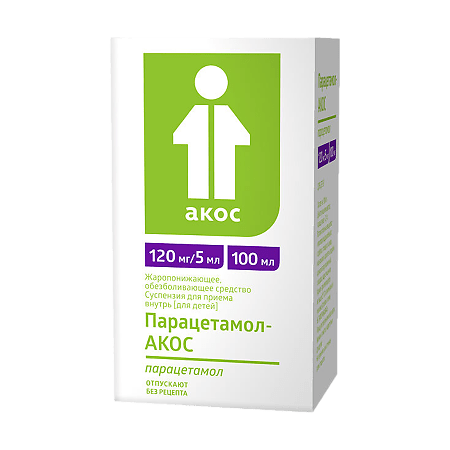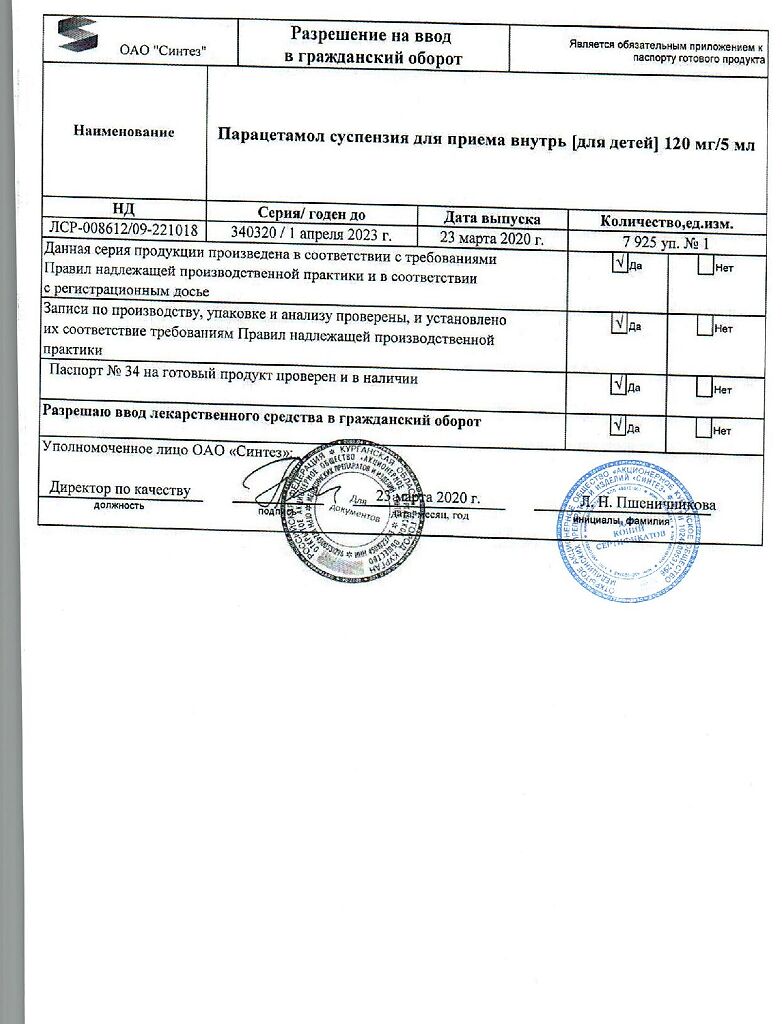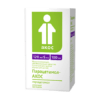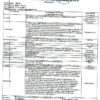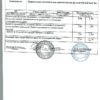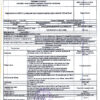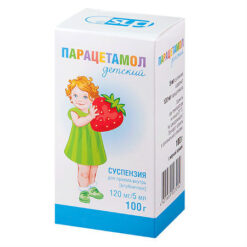No products in the cart.
Paracetamol-ACOS for children, 120 mg/5 ml suspension 100 ml
€1.79 €1.49
Description
Pharmgroup:
An analgesic non-narcotic.
Pharm Action:
Non-narcotic analgesic, blocks COX1 and COX2 mainly in the CNS, affecting the centers of pain and thermoregulation.
In inflamed tissues, cellular peroxidases neutralize the effect of paracetamol on COX, which explains the almost complete absence of anti-inflammatory effect.
The lack of blocking effect on Pg synthesis in peripheral tissues explains its lack of negative effects on water-salt metabolism (Na+ and water retention) and gastrointestinal mucosa.
Indications
Indications
The drug Paracetamol-AKOS is used in children from 3 months. up to 12 years as:
– antipyretic – to reduce elevated body temperature against the background of upper respiratory tract infections, including colds and flu, and childhood infectious diseases (chicken pox, mumps, measles, rubella, scarlet fever, etc.), as well as after vaccination;
– an anesthetic (for pain of mild to moderate intensity) for:
– toothache, including during teething or tooth extraction;
– headaches and migraines;
– sore throat;
– pain in muscles and joints;
– ear pain due to otitis media.
The drug Paracetamol-AKOS can be used in children aged 2 to 3 months. as an antipyretic for colds, as well as once to reduce body temperature after vaccination. If your body temperature does not decrease, you should consult your doctor.
Pharmacological effect
Pharmacological effect
Pharmacotherapeutic group: analgesics; other analgesics and antipyretics; anilides.
ATX code: N02BE01
Pharmacological properties
Pharmacodynamics
Mechanism of action
Paracetamol has antipyretic and analgesic effects. The mechanism of action of paracetamol is believed to be the inhibition of prostaglandin synthesis, primarily in the central nervous system; paracetamol blocks cyclooxygenase in the central nervous system, affecting the centers of pain and thermoregulation. Paracetamol has an extremely small effect on synthesis
prostaglandins in peripheral tissues, so it does not change water-electrolyte metabolism and does not damage the mucous membrane of the gastrointestinal tract. This property of paracetamol makes the drug particularly suitable for patients with a history of gastrointestinal diseases (for example, patients with a history of gastrointestinal bleeding or elderly patients) or patients
taking concomitant medications in which inhibition of peripheral prostaglandins may be undesirable.
Pharmacokinetics
Suction
Paracetamol is quickly and almost completely absorbed from the gastrointestinal tract.
Distribution
At therapeutic concentrations, binding to plasma proteins is minimal and amounts to about 15%. Peak plasma concentrations are reached after 30–60 minutes. The distribution of paracetamol in body fluids is relatively even.
Metabolism
Paracetamol is metabolized in the liver to form several metabolites. In newborns in the first two days of life and in children 3–10 years of age, the main metabolite of paracetamol is paracetamol sulfate; in children 12 years of age and older, it is conjugated glucuronide. Part of the drug (approximately 17%) undergoes hydroxylation to form active metabolites that are conjugated with glutathione. When
In case of glutathione deficiency, these metabolites of paracetamol can block the enzyme systems of hepatocytes and cause their necrosis.
Removal
The half-life when taking a therapeutic dose ranges from 2-3 hours. Paracetamol is excreted by the kidneys in the form of metabolites, mainly glucuroids and sulfates, less than 3% – unchanged.
Special instructions
Special instructions
The simultaneous use of paracetamol with other paracetamol-containing drugs should be avoided, as this may cause an overdose of paracetamol.
An overdose of paracetamol may cause liver failure, which may lead to the need for a liver transplant or death.
Concomitant liver diseases increase the risk of further liver damage when taking Paracetamol-AKOS. Patients who have been diagnosed with liver or kidney failure should consult a physician before use.
Patients with glutathione deficiency due to eating disorders, cystic fibrosis, HIV infection, starvation, malnutrition are susceptible to overdose, so precautions must be taken. Cases of liver failure/impaired liver function have been reported with a small overdose of paracetamol (5 g or more) in patients with low glutathione levels, in particular in extremely malnourished patients suffering from anorexia, chronic alcoholism, patients with a low body mass index or sepsis.
The use of Paracetamol-AKOS by patients with low glutathione levels may increase the risk of developing metabolic acidosis, accompanied by symptoms of rapid breathing, difficulty breathing, nausea, vomiting, and loss of appetite.
If these symptoms occur simultaneously, you should consult a doctor immediately.
In children born prematurely, taking the drug Paracetamol-AKOS is possible only as prescribed by a doctor.
If the febrile syndrome continues during the use of paracetamol for more than 3 days and pain syndrome for more than 5 days, a doctor’s consultation is required.
Distorts laboratory test results in the quantitative determination of glucose and uric acid in plasma.
During long-term treatment (more than 7 days), monitoring of the peripheral blood picture and the functional state of the liver is necessary.
The risk of developing liver damage increases in patients with alcoholic liver disease.
Concomitant use with ethanol is not recommended.
The drug Paracetamol-AKOS contains sorbitol, therefore patients with hereditary fructose intolerance should not use this drug.
The suspension contains 0.04 XE of sucrose per 1 ml, which should be taken into account when treating patients with diabetes.
Paracetamol-AKOS contains glycerin, which can cause headaches, stomach upset and diarrhea.
The drug Paracetamol-AKOS contains methyl parahydroxybenzoate, which can cause allergic reactions (including delayed ones).
Impact on the ability to drive vehicles and machinery
The effect of the drug on the ability to drive vehicles and machines is unlikely.
Active ingredient
Active ingredient
Paracetamol
Composition
Composition
Active substance: paracetamol – .2.4 g.
Excipients: methyl parahydroxybenzoate (nipagin or methylparaben), liquid sorbitol, glycerol (distilled glycerin), xanthan gum, azorubine dye (acid red 2C), strawberry flavor (food flavor “Strawberry”), sucrose (refined sugar), purified water – up to 100 ml.
Pregnancy
Pregnancy
Pregnancy
As with the use of other drugs during pregnancy, you should first consult your doctor before using the drug!
The smallest dose needed to achieve effect should be taken for the shortest possible time.
Breastfeeding period
Paracetamol is excreted in breast milk, but when recommended doses are followed, the amount of paracetamol excreted in breast milk is not clinically significant. According to the results of published clinical studies, the use of
paracetamol is not contraindicated during breastfeeding.
Contraindications
Contraindications
– hypersensitivity to paracetamol or other components of the drug;
– severe dysfunction of the liver and kidneys;
– diseases of the blood system;
– genetic absence of glucose-6-phosphate dehydrogenase;
– age less than 2 months;
– isomaltase and/or sucrase deficiency, fructose intolerance, glucose-galactose malabsorption;
– simultaneous use of other paracetamol-containing drugs, drugs for the treatment of colds and flu, painkillers and antipyretic drugs.
With caution
– dysfunction of the liver and/or kidneys,
– benign hyperbilirubinemia (including Gilbert’s syndrome),
– viral hepatitis,
– diabetes mellitus,
– alcoholic liver damage,
– alcoholism,
– pregnancy,
– period of breastfeeding,
– use in patients with glutathione deficiency (in particular in extremely malnourished patients, anorexic patients or patients with a low body mass index).
– deficiency of the enzyme glucose-6-phosphate dehydrogenase,
– the presence of severe infections, because taking the drug may increase the risk of metabolic acidosis.
Side Effects
Side Effects
At recommended doses, the drug is usually well tolerated.
The following adverse reactions were detected spontaneously during post-registration use of the drug.
Adverse reactions are classified according to body systems and according to the frequency of development. The frequency of adverse reactions is determined as follows: very often (≥1/10), often (≥1/100 and <1/10), infrequently (≥1/1000 and <1/100), rarely (≥1/10,000 and <1/1000), very rarely (<10,000), frequency unknown (frequency cannot be estimated based on available data). data).Blood and lymphatic system disorders:
very rare: thrombocytopenia, anemia, leukopenia.
Immune system disorders:
very rare: anaphylaxis, skin hypersensitivity reactions, including skin rash, pruritus, urticaria, angioedema, Stevens-Johnson syndrome, toxic epidermal necrolysis.
Disorders of the respiratory system, chest and mediastinal organs:
very rare: bronchospasm in patients with hypersensitivity to acetylsalicylic acid and intolerance to other non-steroidal drugs
anti-inflammatory drugs.
Liver and biliary tract disorders:
very rare: liver dysfunction.
Sometimes nausea, vomiting, and pain in the stomach are possible.
Stop taking the drug and consult your doctor immediately if you experience:
– the above adverse reactions;
– allergic reactions such as skin rash or itching, sometimes accompanied by breathing problems, swelling of the lips, tongue, throat or face;
– skin rash or peeling skin, or mouth ulcers;
– bruises and bleeding for unknown reasons;
– history of breathing problems when taking aspirin or NSAIDs;
– history of breathing problems when taking Paracetamol-AKOS.
The drug Paracetamol-AKOS contains methyl parahydroxybenzoate, which can cause allergic reactions (including delayed ones)
Interaction
Interaction
If the child is already taking other medications, you should consult a doctor before starting to take Paracetamol-AKOS.
It is not recommended to take the drug simultaneously with other paracetamol-containing drugs, because this may lead to an overdose of paracetamol. Barbiturates, carbamazepine, phenytoin, diphenin, primidone and other anticonvulsants, ethanol, rifampicin, zidovudine, flumecinol, phenylbutazone, butadione, preparations of St. John’s wort and other inducers of microsomal oxidation increase the production of hydroxylated active metabolites, causing the possibility of developing severe liver damage with small overdoses paracetamol (5 g or more).
Inhibitors of microsomal liver enzymes reduce the risk of hepatotoxicity.
Under the influence of paracetamol, the elimination time of chloramphenicol (chloramphenicol) increases 5 times, resulting in an increased risk of chloramphenicol (chloramphenicol) poisoning.
When taken regularly over a long period of time, the drug enhances the effect of indirect anticoagulants (warfarin and other coumarins), which increases the risk of bleeding. Occasional administration of a single dose of the drug does not have a significant effect on the effect of indirect anticoagulants.
Metoclopramide and domperidone increase, and cholestyramine reduces the rate of absorption of paracetamol. The drug may reduce the effectiveness of uricosuric drugs.
Long-term combined use of paracetamol and other NSAIDs increases the risk of developing “analgesic” nephropathy and renal papillary necrosis, and the onset of end-stage renal failure.
Overdose
Overdose
An overdose of paracetamol can cause liver failure, which may lead to the need for a liver transplant or death. Acute pancreatitis was observed, accompanied by liver dysfunction and hepatotoxicity.
In case of an overdose of Paracetamol-AKOS, even if the patient feels well and there are no significant symptoms of overdose, it is necessary to stop using the drug and immediately consult a doctor for medical assistance.
Symptoms and signs
The hepatotoxic effect in adults occurs when taking paracetamol in an amount of 10 g or more, in children – when taking more than 125 mg/kg of the child’s body weight. If there are factors influencing the toxicity of paracetamol to the liver (see sections “Interaction with other drugs”, “Special instructions”), liver damage may occur after taking paracetamol in an amount of 5 g or more.
With long-term use in excess of the recommended dose, hepatotoxic and nephrotoxic effects (renal colic, nonspecific bacteriuria, interstitial nephritis, papillary necrosis) may be observed.
During the first 24 hours after an overdose, the following symptoms may appear:
nausea, vomiting, stomach pain, impaired glucose metabolism (sweating, dizziness, loss of consciousness), pale skin, decreased appetite, impaired carbohydrate metabolism. Clinical signs of liver damage usually develop after 24–48 hours and reach a maximum after 4–6 days. Signs of impaired glucose metabolism and metabolic acidosis may occur.
In severe cases of overdose, encephalopathy (impaired brain function), bleeding, hypoglycemia, cerebral edema, and even death may develop as a result of liver failure. It is also possible to develop acute renal failure with acute tubular necrosis, the characteristic signs of which are pain in the lumbar region, hematuria (admixture of blood or red blood cells in the urine), proteinuria (increased protein in the urine), while severe liver damage may be absent. There have been cases of heart rhythm disturbances and pancreatitis.
Treatment
If you suspect an overdose of the drug Paracetamol-AKOS, even in the absence of pronounced first symptoms, you must stop using the drug and immediately consult a doctor for medical assistance. During the first hour after an overdose, it is recommended to take enterosorbents (activated carbon, polyphepane). The level of paracetamol in the blood plasma should be determined, but not earlier than 4 hours after the overdose (earlier results are unreliable).
There is no convincing evidence that gastric lavage beyond 60 minutes after overdose improves clinical outcome.
Administration of acetylcysteine within 24 hours after an overdose. The maximum protective effect is ensured during the first 8 hours after an overdose; over time, the effectiveness of the antidote drops sharply. If necessary, acetylcysteine is administered intravenously. In the absence of vomiting, methionine may be used before the patient is admitted to the hospital.
The need for additional therapeutic measures (use of methionine, intravenous administration of acetylcysteine) is determined depending on the concentration of paracetamol in the blood, as well as the time elapsed after its administration.
Treatment of patients with severe liver dysfunction 24 hours after taking paracetamol should be carried out in conjunction with specialists from a poison control center or specialized liver disease department.
When performing tests to determine uric acid and blood sugar levels, tell your doctor about taking Paracetamol-AKOS.
Storage conditions
Storage conditions
At a temperature not exceeding 25 °C, in the original packaging (bottle in a pack).
Do not freeze.
Keep out of the reach of children.
Shelf life
Shelf life
3 years.
Do not use after expiration date.
Manufacturer
Manufacturer
Sintez, Russia
Additional information
| Shelf life | 3 years |
|---|---|
| Conditions of storage | Store in a dry, protected from light and out of the reach of children, at a temperature not exceeding + 25 ° C. |
| Manufacturer | Sintez OAO, Russia |
| Medication form | oral suspension |
| Brand | Sintez OAO |
Other forms…
Related products
Buy Paracetamol-ACOS for children, 120 mg/5 ml suspension 100 ml with delivery to USA, UK, Europe and over 120 other countries.

